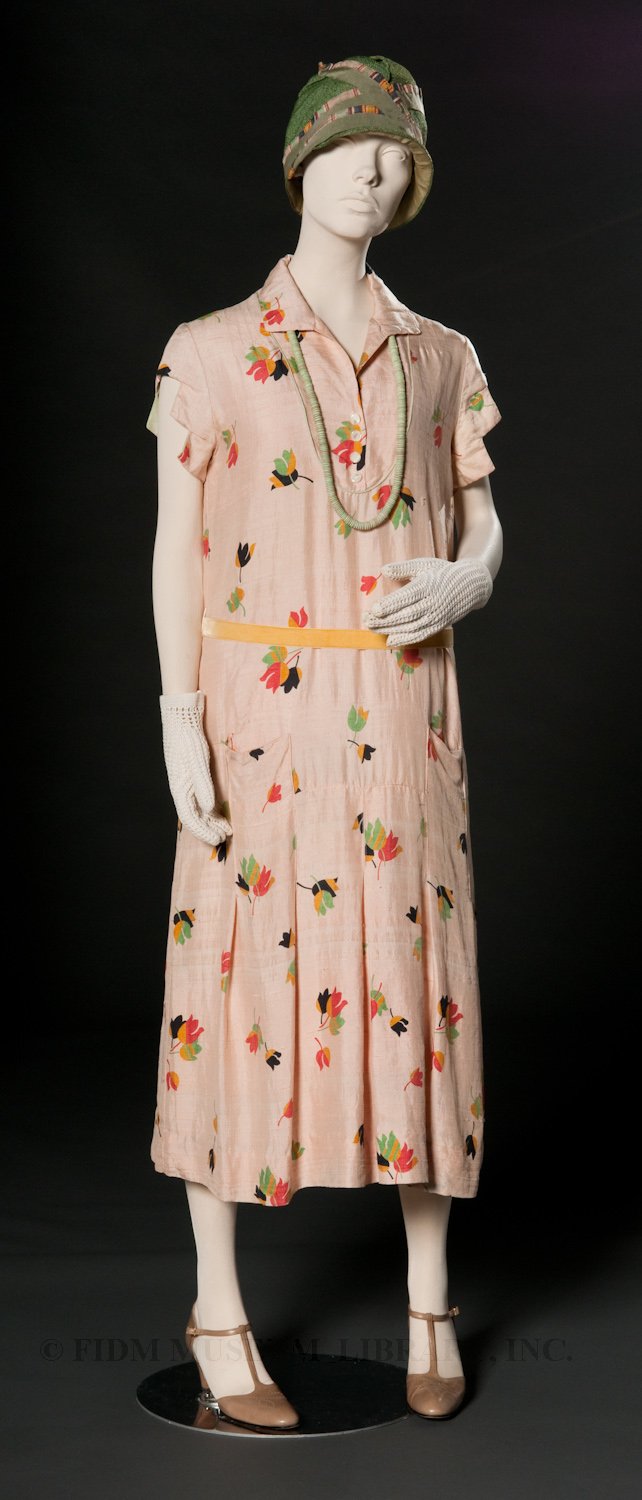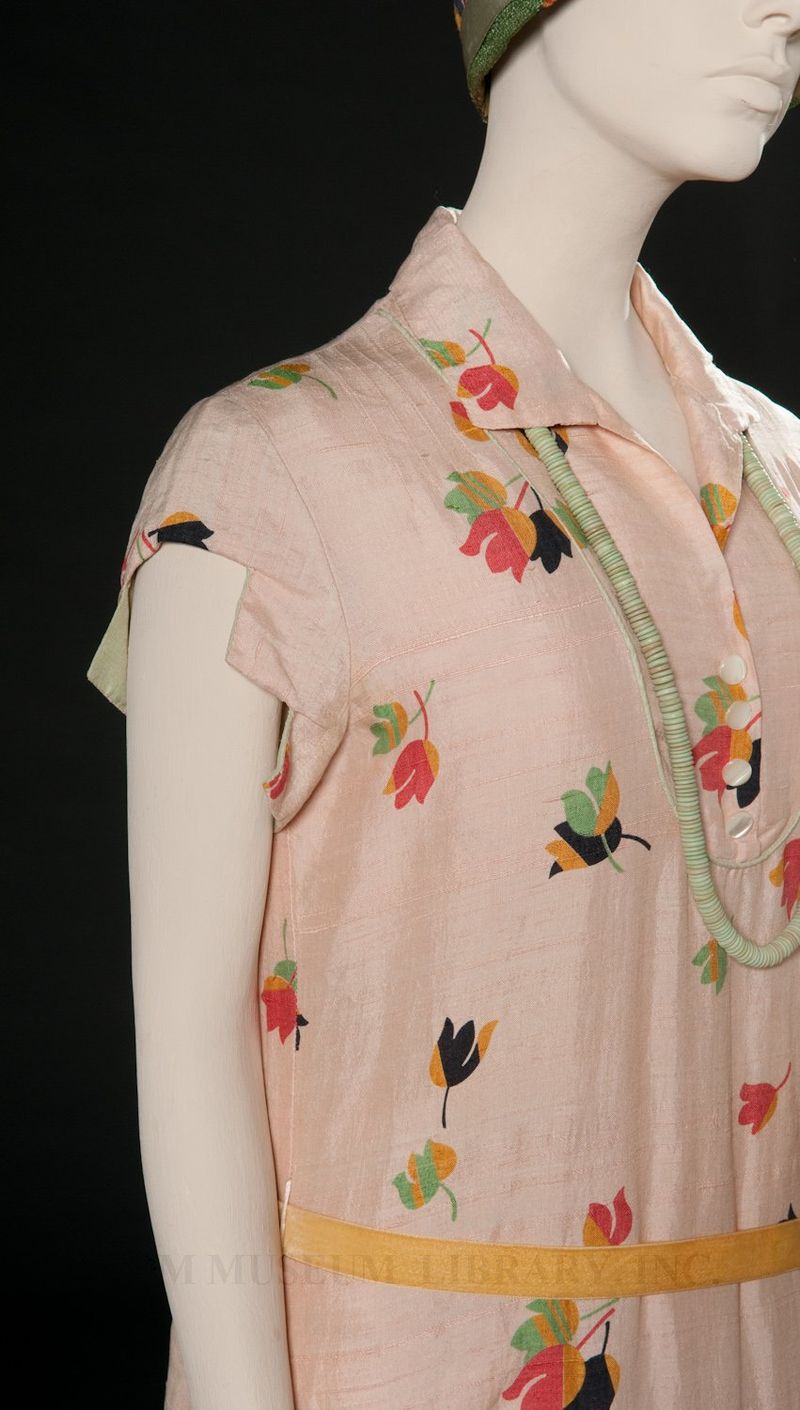The slim, youthful silhouette of 1920s fashion signaled the emergence of a new ideal of feminine beauty. Unlike her predecessors of the late 19th century, who favored the silhouette of a mature, well-endowed woman swathed in layers of fabric, the 1920s woman dressed in a style that emphasized youth. Lightweight daydresses for adult women were designed to expose bare arms and lower legs, parts of the body typically covered by all except young girls. Elasticized undergarments de-emphasized the breasts and hips, creating what is often described as a “boyish” silhouette. The appearance of masculinity was reinforced when women bobbed or cropped their hair.
Daydress
c. 1926
Gift of Santa Monica City College
95.622.1
This shift to a new physical ideal was a move away from the late 19th century idea of the body as a canvas meant to be enhanced by shaping undergarments. Instead, women were expected to reduce their multiple layers of undergarments and possibly even their body mass. Because the physical ideal was slim and slender, “clothing only succeeded in its object of enhancing feminine beauty when worn on a nearly ideally suitable body.”1 For women with a less-than-ideal body, diet and exercise were recommended. Some lamented this overall shift, feeling that it might result in a tyranny of youth and slenderness.
The pale color and delicate floral pattern of this dress convey a youthful feeling, as do the revealing cap sleeves. The elimination of bust dart reveals the intent of the maker, who clearly intended this dress to be worn by a woman with a youthful body type.
Though the 1920s silhouette was soon eclipsed by a series of alternate silhouettes, it’s fascinating to think that some of the issues raised by its emergence are still a part of fashion discourse. “Ideal” body types still tyrannize women, causing some to turn away from the pleasures of fashion and style entirely. Many runway and print models are slender teenagers, a body type idealized by designers when creating garments. This may be shifting, however, as a recent movement to include more voluptuous models on the runway has emerged. Take a look at the Prada 2010 Ready-to-Wear runway images for garments clearly designed for more mature women.
Readers, what do you think? Does the suggestion of a specific, idealized body type cause you to reject (or accept) particular styles? Or the work of particular designers?
1 Steele, Valerie. Fashion and Eroticism: Ideals of Feminine Beauty from the Victorian Era to the Jazz Age. New York: Oxford University Press. 239.




The 1920s silhouette always reminds of the shift from the ultra-feminine New Look silhouette into the 1960s Youthquake. Twiggy, in particular, was so boyish in her looks, with short hair and large eyes, she would have fit in well during the heyday of the 1920s.
The suggestion of a specific body type by certain designers absolutely causes me to avoid their products and seek out other designers. I may be a size 4, but I have an hourglass figure, so what’s the point in even trying to fit into clothes that have been designed for women with a completely different body shape? Those designers are clearly designing for a different shape and different target customer who is obviously not me, so I don’t see much of a point in trying to fit into their clothing. Yeah, it kinda stinks because I so often end up falling in love with clothes that wouldn’t remotely fit me…but I’d much rather accept styles that flatter my body type, even if they’re not the most fashionable styles out there. 😀
Also, I love the choice of mannequin for the display of this garment. The turned in toes…very youthful, almost girlish.
It is interesting to note that while the ideal body type of the 1920s was not particularly suited for all people, it was revolutionary in the fact that it evolved from public demand and not solely the decisions of Parisian designers.
I find it fascinating to look at the somewhat desperate attempts of designers (most notably Lanvin) to reintroduce longer and fuller skirts in the first few years of the 20s to no avail. Newspaper opinion columns from the time actively celebrate this break from Paris, one simply stating “Paris has capitulated. The Ladies win.”
My choices have absolutely been negatively influenced by the runway idiots–my body has never conformed to their tall, skinny, flat forms. My figure is Rubenesque and I am a very healthy and active modern professional woman on a budget. For so many years the runways featured sour, ugly styles and colors! I have learned to sew expertly for myself, inspired by the classic and versatile clothing of China, India, and the interpretations of the Folkwear pattern company, to make clothes that are becoming, beautiful, comfortable, and allow freedom of movement. They also give me a palette for my wonderful jewelry. I consider the “fashion industry” to be hostile to real working women, seeking to make a profit without concern for providing a useful product, and I see fashion victims all over the place, in my college classrooms as well as in faculty meetings. They are another example of image overtaking function, leading millions of women down a path of deformity and debt. At the same time, I love beautiful fabrics and enjoy studying the historic techniques and fabrics featured in the FIDM. Sometimes I can adapt them to my own clothes and those of my friends and relatives.
Why can’t we have more than one ideal body type on the runway? Why can’t they be healthy women instead of anorexic children or drugged teenage zombies? We would do so many girls a service to show them beauty as part of health. I love fashion, and remember my mother’s pleasure in the 1950s in luncheons and fashion shows. So I am grounded in health and real life, and look at “high fashion” only as a distant spectacle.
Wow…thanks for all of the comments. Seems like the idea of a physical ideal has struck a nerve with some readers!
Kristina, I do think that there is a move afoot to introduce models with more diverse body types. This blog post from The Cut talks about the most recent issue of French Elle, which featured larger models: http://nymag.com/daily/fashion/2010/03/french_elle_devoted_the_april.html If you read through the comments on this post, one of the complaints has to do with the fact that French Elle is swinging to the opposite end of the spectrum and not featuring any women in-between. I’m definitely going to keep tabs on this emerging debate.
Kat, I agree! It’s much more appealing to wear what flatters rather than what is currently in fashion.
Meghan, you make a great point! I’ve never thought of the shift in those terms, but you’re right about Twiggy.
Samantha, I noticed a similar spirit when researching this post. Women did seem to prefer the slim silhouette to the fuller skirts. Perhaps the break with the past, and the association with up-to-the-minute modernity was irresistible.
Thanks for your link–I didn’t mean to go on quite so loudly. I just get very discouraged for myself and for my students, many of whom are glowing with health, when we are constantly confronted by impossible fashion images and ideals. It would be nice to see curves and a bit less mannishness on the runways.
I’m with Kat. I’m not quite as small as she is but as a 6 or 8, I’m not in the overweight category frequently euphemized as “curvy.” I just have a very small waist compared to my rather large hips. I’m also a writer interested in the problems created by the intersection of human variation (biological, tastes, values) and both mass markets and technocratic government. All of which led me to write this piece on clothing sizes: http://www.theatlantic.com/magazine/archive/2007/12/rightsize-me/6435/
Virginia, thanks for the link to your article! It’s an interesting read.
Why is it that when referring to slender women it’s always “youthful” and “boyish” and when referring to heavier women it’s always “mature” and “womanly”? Am I less of an adult woman because I’m slender? All this talk about putting “real women” on runways and in fashion mags, assumes that those who already are on runways and fashion mags aren’t real women. Oh, I know, you are calling for all body types to be represented, but the fact is clothing looks better on tall slim women, no matter what era of clothing we’re talking about. Yes, Victorian clothing emphasized bust and hips, but how many of you larger girls want to stuff yourselves into corsets? Is it not healthier to have a fashion ideal that can be obtained with diet and exercise, than one that can really only be had through restrictive, and painful undergarments?
And really, how new is this 1920s ideal anyway? In the late 1700s/early1800s, was not the corseted ideal abandoned in favor of the high-waisted, natural figure? I admit, the 1920s didn’t emphasize the bust like the Regency era did, but both fashions tried to complement the female form in a less restrictive way.
Thank you for the link, Ms. Postrel–interesting and informative! And no, Ann, being slender is not less womanly, but it’s less frustrating when shopping for clothes, and that ideal is not attainable for some of us. Since puberty my breasts and hips have been prominent features, at any weight, and my height has remained 5’4″ without variation. Custom sewing solves the problem for me and many of my friends and relations; it would be a welcome option for many others too. My frustration has been relieved by the growth of the catalog industry, as I live in a rural area where a mall visit involves hours of driving. Perhaps it has always been the case that high fashion has been the province of wealthy city women?
Wooo so interesting